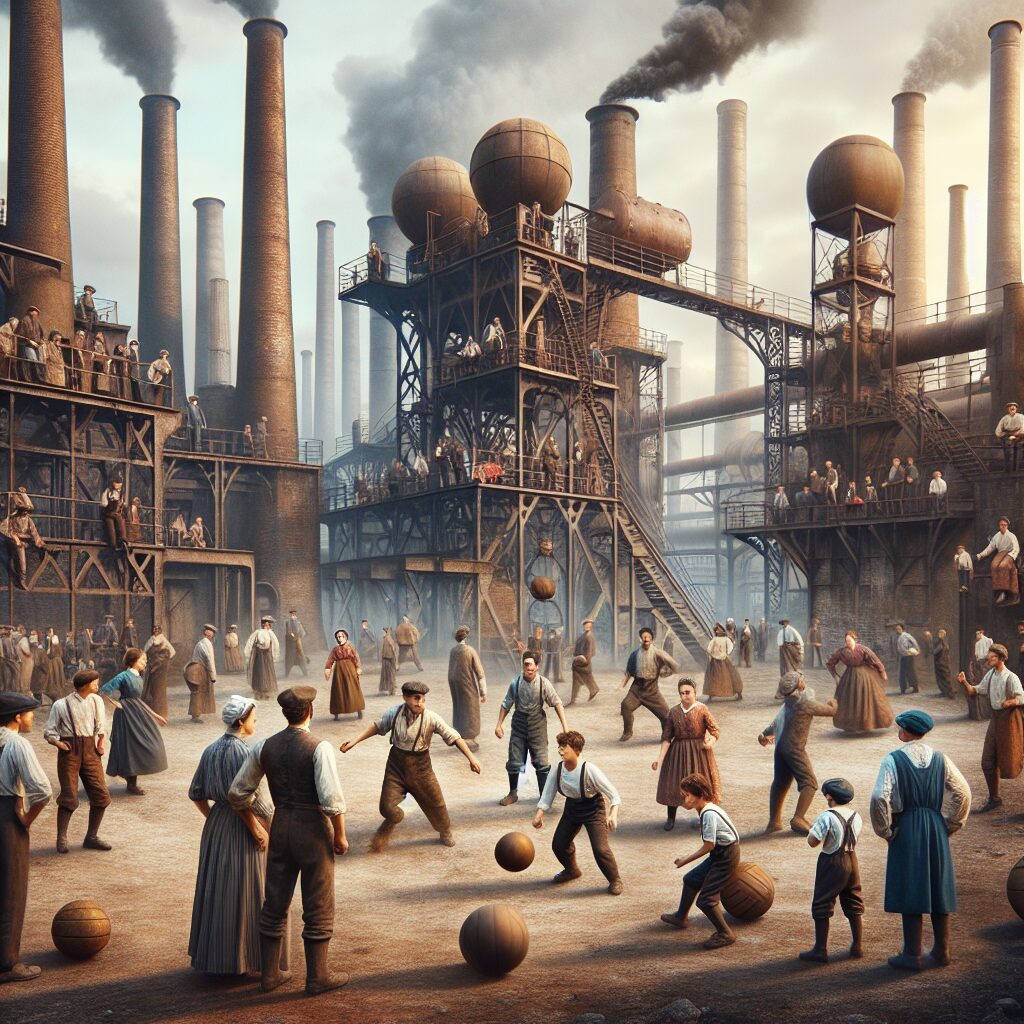During the Industrial Revolution, ball games emerged as a popular form of leisure and entertainment. These games provided a much-needed escape from the harsh realities of working in factories and mills. Men, women, and children alike eagerly participated in various ball games, forming their own leagues and teams in industrial towns across the world. One unique feature of ball games during this era was the transformation of traditional sports into organized, competitive events. Games such as baseball, football, and cricket gained momentum and began to evolve into the structured sports we know today.
Now that we have explored the emergence and transformation of ball games during the Industrial Revolution, let’s dive into the key takeaways. First, we will discuss how these games served as a means of escape and entertainment for workers. We will also examine the societal impacts of organized ball games, including the promotion of teamwork and the development of physical fitness. Additionally, we will explore how the Industrial Revolution influenced the evolution of traditional sports, paving the way for the modern-day versions we enjoy today. So, sit back and join us on this journey as we explore the fascinating world of ball games during this transformative period in history.
Key Takeaways
1. Ball games during the Industrial Revolution provided valuable recreational opportunities for workers in urban areas, helping to alleviate the monotony and stress of their labor-intensive lives.
2. Popular ball games such as football and cricket became a significant part of the cultural fabric of the working class, fostering a sense of community and camaraderie among players and spectators alike.
3. The accessibility and affordability of ball games made them popular among people of all social classes, connecting individuals from different backgrounds and breaking down social barriers.
4. The rise of ball games during this period contributed to the professionalization of sports and the creation of organized leagues, paving the way for the development of modern sporting events.
5. The growth of ball games also reflected the changing nature of recreation and leisure activities, as industrialization reshaped society and provided people with more free time to engage in sports and other pastimes.
Ball Games During the Industrial Revolution
1. Cricket
Cricket was a prevalent ball game during the Industrial Revolution. Originating in England, it gained immense popularity during this era. Matches were played between teams of eleven players, with each team taking turns to bat and field. The game involved hitting the ball with a wooden bat and scoring runs by running between two sets of wooden stumps placed at each end of the pitch. Cricket became a symbol of national identity and a favorite pastime for both the working class and the elite.
2. Rounders
Rounders, an early form of baseball, was also widely played during the Industrial Revolution. It was particularly popular among children and served as a recreational sport in schools and communities. The game involved hitting a small ball with a wooden stick and running around a series of bases to score points. Rounders played a significant role in improving hand-eye coordination and physical fitness, making it a favored ball game among youngsters.
3. Football
Football, or soccer as it is known in some regions, is another ball game with roots dating back to the Industrial Revolution. While football had been played for centuries, it gained significant structure and popularity during this era. The game involved two teams attempting to score goals by kicking a ball into the opposing team’s net. Football became a source of entertainment for both players and spectators, with numerous matches organized in factories, schools, and local communities.
4. Base Ball (Early Baseball)
Base Ball, an early form of baseball, was played during the Industrial Revolution. The game shared similarities with today’s baseball and involved hitting a ball with a wooden bat and running around bases to score runs. However, the rules and gameplay of Base Ball varied across different regions and evolving over time. It became a popular recreational sport, played in urban areas and working-class neighborhoods.
5. Bowling
Bowling was a ball game commonly enjoyed by people during the Industrial Revolution. Traditional lawn bowling evolved into indoor versions, such as skittles and ninepins. Players would roll a ball to knock down a set of pins, aiming for the highest score. Bowling provided a social atmosphere and was often played in taverns or gathering places, offering a leisure activity for both men and women.
6. Tips for Playing Ball Games During the Industrial Revolution
- Ensure you have the necessary equipment for the specific ball game you are playing, such as cricket bats, balls, goals, or wooden sticks.
- Familiarize yourself with the rules and regulations of the game before participating.
- Engage in regular physical activity and warm-up exercises to prevent injuries and enhance performance.
- Join local clubs or teams to enjoy a competitive environment and improve your skills.
- Explore various ball games to experience different playing styles and broaden your sporting knowledge.
- Respect fair play and sportsmanship, treating opponents with courtesy and integrity.
- Stay hydrated and take breaks when necessary to avoid exhaustion and fatigue during extended gameplay.
- Embrace the social aspect of ball games by involving friends, family, and colleagues.
- Have fun! Remember that ball games were primarily intended for enjoyment and recreation.
Ball Games During the Industrial Revolution
FAQ
1. What were the popular ball games played during the Industrial Revolution?
During the Industrial Revolution, some popular ball games that were played included cricket, baseball, football (soccer), and rugby. These games gained popularity among both the working class and the upper class, providing a means of entertainment and physical activity.
2. How did the Industrial Revolution impact the development of ball games?
The Industrial Revolution had a significant impact on the development of ball games. With the rise of factories and urbanization, more people had leisure time, leading to the increased popularity of sports. Additionally, advancements in technology, such as the production of synthetic materials for balls and the creation of organized sports leagues, further facilitated the growth and standardization of ball games.
3. Were ball games exclusively for men during the Industrial Revolution?
No, ball games were not exclusively for men. While they were predominantly played by men, women also participated in various ball games during the Industrial Revolution. However, societal norms and gender roles often limited women’s involvement in sports, leading to less visibility and recognition for female athletes.
4. Were there any restrictions on who could play ball games during this time?
In general, ball games were accessible to individuals of different social classes during the Industrial Revolution. However, there were certain restrictions depending on the specific game and location. For example, some clubs or teams may have had membership requirements or exclusive access to certain facilities. Additionally, socio-economic conditions could impact an individual’s ability to participate due to limited resources or time constraints.
5. Did ball games serve any other purposes beyond entertainment during the Industrial Revolution?
Yes, ball games served other purposes besides entertainment during the Industrial Revolution. They provided an outlet for physical exercise, promoting health and fitness. Additionally, ball games often fostered a sense of camaraderie, teamwork, and discipline, instilling important values that were beneficial both on and off the field.
6. How did the playing conditions and equipment differ from modern ball games?
The playing conditions and equipment for ball games during the Industrial Revolution differed significantly from modern standards. Fields were often uneven and lacked proper drainage, making gameplay challenging. The balls used were typically handmade and made of materials such as leather, which were less durable compared to the synthetic materials used today. Rules and regulations also evolved over time, leading to variations in gameplay compared to contemporary versions of the games.
7. Were ball games organized into formal leagues during the Industrial Revolution?
Yes, ball games were organized into formal leagues during the Industrial Revolution. As the popularity of these sports grew, various clubs and organizations emerged to facilitate competitive gameplay. Leagues and tournaments were established, allowing teams to participate in organized competitions and showcase their skills.
8. Did children play ball games during the Industrial Revolution?
Yes, children also played ball games during the Industrial Revolution. Similar to adults, ball games served as a form of recreation for children, allowing them to socialize, develop physical skills, and have fun. However, the types of games and rules for children may have varied, depending on societal norms and cultural practices of the time.
9. Were there any safety concerns associated with ball games during this period?
Yes, safety concerns were associated with ball games during the Industrial Revolution. Limited regulations and safety measures meant that injuries were more common compared to contemporary standards. Additionally, the conditions of the playing fields and the use of less advanced equipment increased the risk of accidents and injuries during gameplay.
10. How did the Industrial Revolution contribute to the globalization of ball games?
The Industrial Revolution played a pivotal role in the globalization of ball games. The increased mobility and interconnectedness brought about by industrialization enabled the spread of sports across different regions and countries. This facilitated the exchange of playing styles, tactics, and rules, ultimately leading to the global popularity and standardization of ball games we see today.
Final Thoughts
Ball games during the Industrial Revolution revolutionized the concept of leisure and physical activity. The availability of free time, coupled with the advancements in technology, allowed for the development and expansion of various sports. These games not only provided entertainment but also became a means for people to engage in healthy competition, promote teamwork, and stay physically fit.
Moreover, the impact of ball games during this era extended beyond recreation. They acted as powerful tools for social integration, breaking down class barriers as people from different backgrounds played alongside each other. Additionally, the rise of organized leagues and competitions fostered a sense of community and belonging, further contributing to the overall well-being of individuals during the Industrial Revolution.




